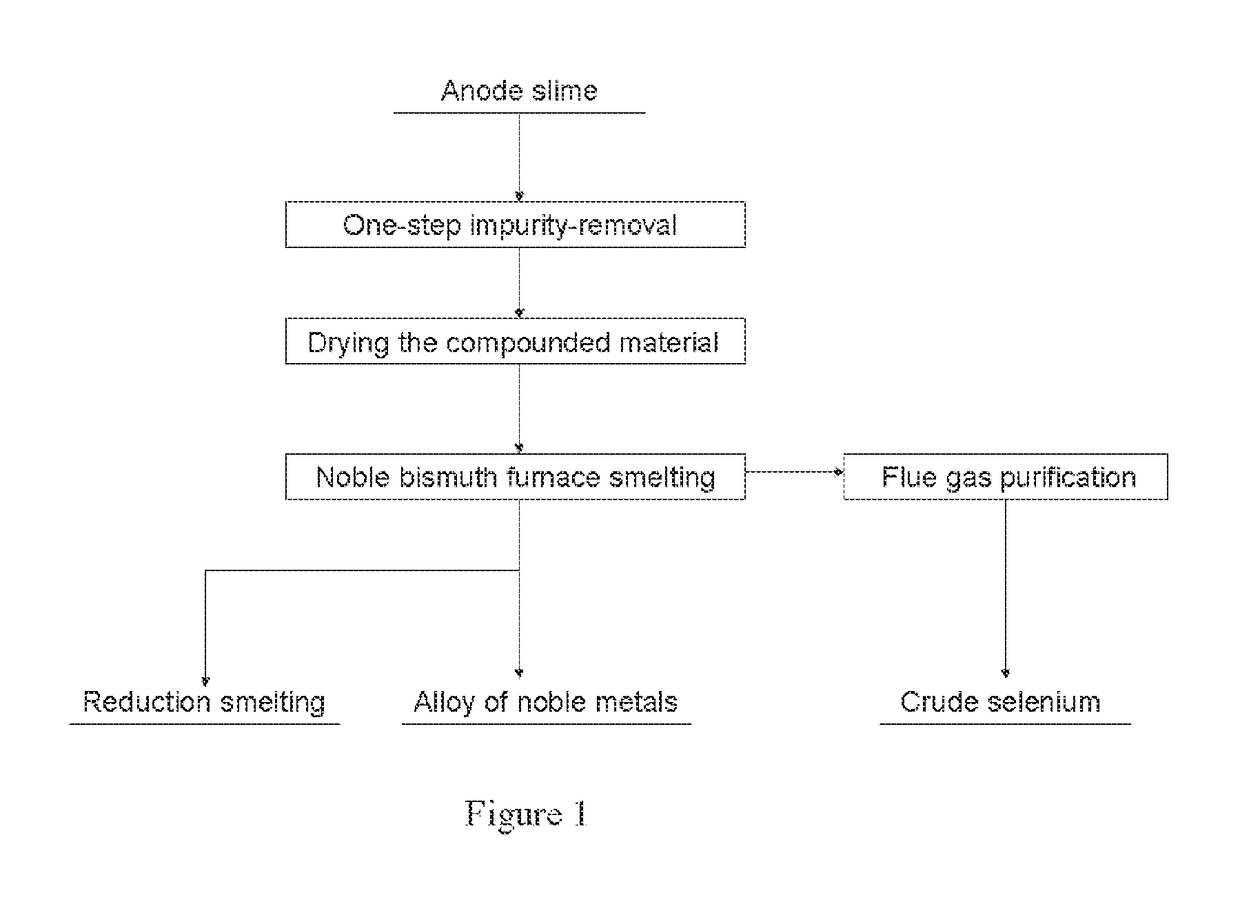Process for extracting noble metals from anode slime
a noble metal and anode slime technology, applied in the field of noble metal technology, can solve the problems of rare and noble metal resources in china, which are extremely scarce, and only comprise 0.48% of global reserves, and achieve the effects of short smelting time, short smelting time and high production efficiency
- Summary
- Abstract
- Description
- Claims
- Application Information
AI Technical Summary
Benefits of technology
Problems solved by technology
Method used
Image
Examples
example 1
[0065]Copper anode slime was selected and used for extracting noble metals, wherein the components of the copper anode slime selected and used in this example are shown in Table 2, which is a table of the components in the copper anode slime.
TABLE 2Test components in the copper anode slimeElementAuAgSeCuAsSbPbTeBiImpurities%0.556.0004.5124.728.5215Balance
1. One-Step Removal of Impurities from the Copper Anode Slime
[0066]The copper anode slime was added to a compounding tank, and then water and concentrated sulfuric acid were added to formulate a pressure leaching solution, wherein a mass ratio of water, concentrated sulfuric acid and copper anode slime was 3:4:1; after being formulated the pressure leaching solution was pumped into an autoclave for a two-stage oxygen pressure continuous leaching, with the first stage oxygen pressure leaching controlled under 0.9 MPa at a temperature of 150° C. and the second stage oxygen pressure leaching controlled under 1.0 MPa at a temperature of...
example 2
[0089]Lead anode slime was selected and used for extracting noble metals, wherein the components in the lead anode slime selected and used in this example are shown in Table 7, which is a table of the components in the lead anode slime.
TABLE 7Components in the lead anode slimeElementAuAgSeCuAsTeSbPbBi%0.3510.002.55.06.70.5201018
1. One-Step Removal of Impurities from the Lead Anode Slime
[0090]The lead anode slime was added to a compounding tank, and then water and concentrated sulfuric acid were added to formulate a pressure leaching solution, wherein a mass ratio of water, concentrated sulfuric acid and lead anode slime was 3:4:1; after being formulated the pressure leaching solution was pumped into an autoclave for a two-stage oxygen pressure continuous leaching, with the first stage oxygen pressure leaching controlled under 0.8 MPa at a temperature of 150° C. and the second stage oxygen pressure leaching controlled under 1.0 MPa at a temperature of 140° C. After the reaction was c...
example 3
[0114]Mixed anode slime of copper anode slime and lead anode slime was selected and used for extracting noble metals, wherein the components in the mixed anode slime selected and used in this example are shown in Table 12 and 13, which are tables of the components in the copper anode slime and the lead anode slime, respectively.
TABLE 12Components in the copper anode slimeElementAuAgSeCuAsSbPbTeBi%0.556.0004.59.54.728.5215
TABLE 13Components in the lead anode slimeElementAuAgSeCuAsTeSbPbBi%0.3510.002.52.56.70.5201013
1. One-Step Removal of Impurities from the Mixed Anode Slime
[0115]The copper anode slime and the lead anode slime having the above components in a mass ratio of 2:1 were added to a compounding tank, and water, concentrated sulfuric acid and the anode slime were added to the compounding tank in a mass ratio of 3:4:1 to formulate a pressure leaching solution; after being formulated the pressure leaching solution was pumped into an autoclave for a two-stage oxygen pressure co...
PUM
| Property | Measurement | Unit |
|---|---|---|
| temperature | aaaaa | aaaaa |
| melt temperature | aaaaa | aaaaa |
| melt temperature | aaaaa | aaaaa |
Abstract
Description
Claims
Application Information
 Login to View More
Login to View More - R&D
- Intellectual Property
- Life Sciences
- Materials
- Tech Scout
- Unparalleled Data Quality
- Higher Quality Content
- 60% Fewer Hallucinations
Browse by: Latest US Patents, China's latest patents, Technical Efficacy Thesaurus, Application Domain, Technology Topic, Popular Technical Reports.
© 2025 PatSnap. All rights reserved.Legal|Privacy policy|Modern Slavery Act Transparency Statement|Sitemap|About US| Contact US: help@patsnap.com

